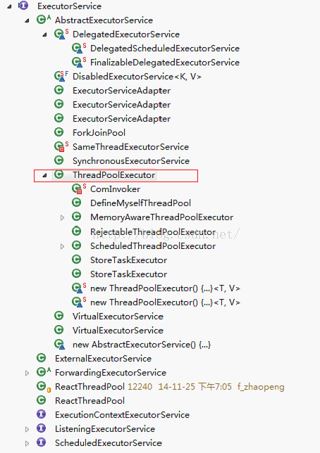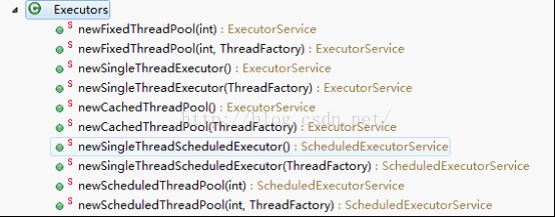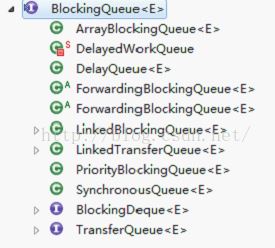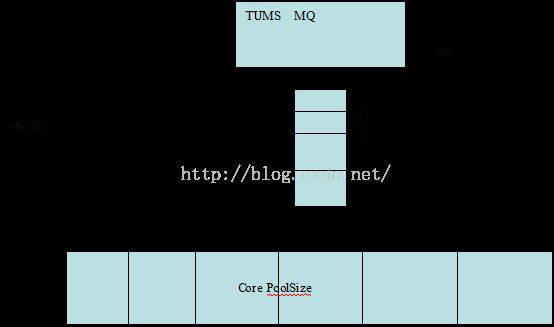一、简介
多线程技术主要解决处理器单元内多个线程执行的问题,它可以显著减少处理器单元的闲置时间,增加处理器单元的吞吐能力,但频繁的创建线程的开销是很大的,那么如何来减少这部分的开销了,那么就要考虑使用线程池了。线程池就是一个线程的容器,每次只执行额定数量的线程,线程池就是用来管理这些额定数量的线程。
二、涉及线程池的类结构图

其中供我们使用的,主要是threadpoolexecutor类。
三、如何创建线程池
我们创建线程池一般有以下几种方法:
1、使用executors工厂类
executors主要提供了下面几种创建线程池的方法:

下面来看下使用示例:
1)newfixedthreadpool(固定大小的线程池)
|
1
2
3
4
5
6
7
8
9
10
11
12
13
14
15
|
public class fixedthreadpool { public static void main(string[] args) { executorservice pool = executors.newfixedthreadpool(5);// 创建一个固定大小为5的线程池 for (int i = 0; i < 10; i++) { pool.submit(new mythread()); } pool.shutdown(); } } public class mythread extends thread { @override public void run() { system.out.println(thread.currentthread().getname() + "正在执行。。。"); } } |
测试结果如下:
pool-1-thread-1正在执行。。。
pool-1-thread-2正在执行。。。
pool-1-thread-3正在执行。。。
pool-1-thread-2正在执行。。。
pool-1-thread-3正在执行。。。
pool-1-thread-2正在执行。。。
pool-1-thread-2正在执行。。。
pool-1-thread-3正在执行。。。
pool-1-thread-5正在执行。。。
pool-1-thread-4正在执行。。。
固定大小的线程池:每次提交一个任务就创建一个线程,直到线程达到线程池的最大大小。线程池的大小一旦达到最大值就会保持不变,如果某个线程因为执行异常而结束,那么线程池会补充一个新线程线。
2)newsinglethreadexecutor(单线程的线程池)
|
1
2
3
4
5
6
7
8
9
|
public class singlethreadpool { public static void main(string[] args) { executorservice pool=executors.newsinglethreadexecutor();//创建一个单线程池 for(int i=0;i<100;i++){ pool.submit(new mythread()); } pool.shutdown(); } } |
测试结果如下:
pool-1-thread-1正在执行。。。
pool-1-thread-1正在执行。。。
pool-1-thread-1正在执行。。。
pool-1-thread-1正在执行。。。
pool-1-thread-1正在执行。。。
pool-1-thread-1正在执行。。。
pool-1-thread-1正在执行。。。
pool-1-thread-1正在执行。。。
pool-1-thread-1正在执行。。。
pool-1-thread-1正在执行。。。
单线程的线程池:这个线程池只有一个线程在工作,也就是相当于单线程串行执行所有任务。如果这个唯一的线程因为异常结束,那么会有一个新的线程来替代它。此线程池保证所有任务的执行顺序按照任务的提交顺序执行。
3)newscheduledthreadpool
|
1
2
3
4
5
6
7
8
9
10
11
12
|
public class scheduledthreadpool { public static void main(string[] args) { scheduledexecutorservice pool=executors.newscheduledthreadpool(6); for(int i=0;i<10000;i++){ pool.submit(new mythread()); } pool.schedule(new mythread(), 1000, timeunit.milliseconds); pool.schedule(new mythread(), 1000, timeunit.milliseconds); pool.shutdown(); } } |
测试结果如下:
pool-1-thread-1正在执行。。。
pool-1-thread-6正在执行。。。
pool-1-thread-5正在执行。。。
pool-1-thread-4正在执行。。。
pool-1-thread-2正在执行。。。
pool-1-thread-3正在执行。。。
pool-1-thread-4正在执行。。。
pool-1-thread-5正在执行。。。
pool-1-thread-6正在执行。。。
pool-1-thread-1正在执行。。。
…………此处会延时1s…………
pool-1-thread-4正在执行。。。
pool-1-thread-1正在执行。。。
测试结果的最后两个线程都是在延时1s之后,才开始执行的。此线程池支持定时以及周期性执行任务的需求
4)newcachedthreadpool(可缓存的线程池)
|
1
2
3
4
5
6
7
8
9
|
public class cachedthreadpool { public static void main(string[] args) { executorservice pool=executors.newcachedthreadpool(); for(int i=0;i<100;i++){ pool.submit(new mythread()); } pool.shutdown(); } } |
测试结果如下:
pool-1-thread-5正在执行。。。
pool-1-thread-7正在执行。。。
pool-1-thread-5正在执行。。。
pool-1-thread-16正在执行。。。
pool-1-thread-17正在执行。。。
pool-1-thread-16正在执行。。。
pool-1-thread-5正在执行。。。
pool-1-thread-7正在执行。。。
pool-1-thread-16正在执行。。。
pool-1-thread-18正在执行。。。
pool-1-thread-10正在执行。。。
可缓存的线程池:如果线程池的大小超过了处理任务所需要的线程,那么就会回收部分空闲(60秒不执行任务)的线程,当任务数增加时,此线程池又可以智能的添加新线程来处理任务。此线程池不会对线程池大小做限制,线程池大小完全依赖于操作系统(或者说jvm)能够创建的最大线程大小。
官方建议程序员使用较为方便的executors工厂方法executors.newcachedthreadpool()(无界线程池,可以进行自动线程回收)、executors.newfixedthreadpool(int)(固定大小线程池)executors.newsinglethreadexecutor()(单个后台线程),这几种线程池均为大多数使用场景预定义了默认配置。
2、继承threadpoolexecutor类,并复写父类的构造方法。
在介绍这种方式之前,我们来分析下前面几个创建线程池的底层代码是怎样的?
|
1
2
3
4
5
6
7
8
9
10
11
12
13
|
public class executors { public static executorservice newfixedthreadpool(int nthreads) { return new threadpoolexecutor(nthreads, nthreads, 0l, timeunit.milliseconds, new linkedblockingqueue<runnable>()); } public static executorservice newsinglethreadexecutor() { return new finalizabledelegatedexecutorservice (new threadpoolexecutor(1, 1, 0l, timeunit.milliseconds, new linkedblockingqueue<runnable>())); } } |
从executors工厂类的底层代码可以看出,工厂类提供的创建线程池的方法,其实都是通过构造threadpoolexecutor来实现的。threadpoolexecutor构造方法代码如下:
|
1
2
3
4
5
6
7
8
9
10
11
12
13
14
15
16
17
18
19
20
21
|
public threadpoolexecutor(int corepoolsize, int maximumpoolsize, long keepalivetime, timeunit unit, blockingqueue<runnable> workqueue, threadfactory threadfactory, rejectedexecutionhandler handler) { if (corepoolsize < 0 || maximumpoolsize <= 0 || maximumpoolsize < corepoolsize || keepalivetime < 0) throw new illegalargumentexception(); if (workqueue == null || threadfactory == null || handler == null) throw new nullpointerexception(); this.corepoolsize = corepoolsize; this.maximumpoolsize = maximumpoolsize; this.workqueue = workqueue; this.keepalivetime = unit.tonanos(keepalivetime); this.threadfactory = threadfactory; this.handler = handler; } |
那么接下来,我们就来谈谈这个threadpoolexecutor构造方法。在这个构造方法中,主要有以下几个参数:
corepoolsize--池中所保存的线程数,包括空闲线程。
maximumpoolsize--池中允许的最大线程数。
keepalivetime--当线程数大于corepoolsize时,此为终止空闲线程等待新任务的最长时间。
unit--keepalivetime 参数的时间单位。
workqueue--执行前用于保持任务的队列。此队列仅保持由 execute方法提交的 runnable任务。
threadfactory--执行程序创建新线程时使用的工厂。
handler--由于超出线程范围和队列容量而使执行被阻塞时所使用的处理程序。
接下来,咋们来说下这几个参数之间的关系。当线程池刚创建的时候,线程池里面是没有任何线程的(注意,并不是线程池一创建,里面就创建了一定数量的线程),当调用execute()方法添加一个任务时,线程池会做如下的判断:
1)如果当前正在运行的线程数量小于corepoolsize,那么立刻创建一个新的线程,执行这个任务。
2)如果当前正在运行的线程数量大于或等于corepoolsize,那么这个任务将会放入队列中。
3)如果线程池的队列已经满了,但是正在运行的线程数量小于maximumpoolsize,那么还是会创建新的线程,执行这个任务。
4)如果队列已经满了,且当前正在运行的线程数量大于或等于maximumpoolsize,那么线程池会根据拒绝执行策略来处理当前的任务。
5)当一个任务执行完后,线程会从队列中取下一个任务来执行,如果队列中没有需要执行的任务,那么这个线程就会处于空闲状态,如果超过了keepalivetime存活时间,则这个线程会被线程池回收(注:回收线程是有条件的,如果当前运行的线程数量大于corepoolsize的话,这个线程就会被销毁,如果不大于corepoolsize,是不会销毁这个线程的,线程的数量必须保持在corepoolsize数量内).为什么不是线程一空闲就回收,而是需要等到超过keepalivetime才进行线程的回收了,原因很简单:因为线程的创建和销毁消耗很大,更不能频繁的进行创建和销毁,当超过keepalivetime后,发现确实用不到这个线程了,才会进行销毁。这其中unit表示keepalivetime的时间单位,unit的定义如下:
|
1
2
3
4
5
6
7
8
9
10
11
12
13
14
15
16
17
18
19
20
21
22
|
public enum timeunit { nanoseconds { // keepalivetime以纳秒为单位 }, microseconds { // keepalivetime以微秒为单位 }, milliseconds { // keepalivetime以毫秒为单位 }, seconds { // keepalivetime以秒为单位 }, minutes { // keepalivetime以分钟为单位 }, hours { // keepalivetime以小时为单位 }, days { // keepalivetime以天为单位 }; |
下面从源码来分析一下,对于上面的几种情况,主要涉及到的源码有以下几块:
|
1
2
3
4
5
6
7
8
9
10
11
12
13
14
15
|
private boolean addifundercorepoolsize(runnable firsttask) { thread t = null; final reentrantlock mainlock = this.mainlock; mainlock.lock(); try { if (poolsize < corepoolsize && runstate == running) t = addthread(firsttask); } finally { mainlock.unlock(); } if (t == null) return false; t.start(); return true; } |
其实,这段代码很简单,主要描述的就是,如果当前的线程池小于corepoolsize的时候,是直接新建一个线程来处理任务。
|
1
2
3
4
5
6
7
8
9
10
11
12
13
14
15
|
private boolean addifundermaximumpoolsize(runnable firsttask) { thread t = null; final reentrantlock mainlock = this.mainlock; mainlock.lock(); try { if (poolsize < maximumpoolsize && runstate == running) t = addthread(firsttask); } finally { mainlock.unlock(); } if (t == null) return false; t.start(); return true; } |
上面这段代码描述的是,如果当前线程池的数量小于maximumpoolsize的时候,也会创建一个线程,来执行任务
四、线程池的队列
线程池的队列,总的来说有3种:
直接提交:工作队列的默认选项是 synchronousqueue,它将任务直接提交给线程而不保持它们。在此,如果不存在可用于立即运行任务的线程,则试图把任务加入队列将失败,因此会构造一个新的线程。此策略可以避免在处理可能具有内部依赖性的请求集时出现锁。直接提交通常要求无界 maximumpoolsizes 以避免拒绝新提交的任务。当命令以超过队列所能处理的平均数连续到达时,此策略允许无界线程具有增长的可能性。
无界队列:使用无界队列(例如,不具有预定义容量的 linkedblockingqueue)将导致在所有 corepoolsize 线程都忙时新任务在队列中等待。这样,创建的线程就不会超过 corepoolsize。(因此,maximumpoolsize的值也就无效了。)当每个任务完全独立于其他任务,即任务执行互不影响时,适合于使用无界队列;例如,在 web页服务器中。这种排队可用于处理瞬态突发请求,当命令以超过队列所能处理的平均数连续到达时,此策略允许无界线程具有增长的可能性。
有界队列:当使用有限的 maximumpoolsizes时,有界队列(如 arrayblockingqueue)有助于防止资源耗尽,但是可能较难调整和控制。队列大小和最大池大小可能需要相互折衷:使用大型队列和小型池可以最大限度地降低 cpu 使用率、操作系统资源和上下文切换开销,但是可能导致人工降低吞吐量。如果任务频繁阻塞(例如,如果它们是 i/o边界),则系统可能为超过您许可的更多线程安排时间。使用小型队列通常要求较大的池大小,cpu使用率较高,但是可能遇到不可接受的调度开销,这样也会降低吞吐量。
下面就来说下线程池的队列,类结构图如下:

1)synchronousqueue
该队列对应的就是上面所说的直接提交,首先synchronousqueue是无界的,也就是说他存数任务的能力是没有限制的,但是由于该queue本身的特性,在某次添加元素后必须等待其他线程取走后才能继续添加。
2)linkedblockingqueue
该队列对应的就是上面的无界队列。
3)arrayblockingqueue
该队列对应的就是上面的有界队列。arrayblockingqueue有以下3中构造方法:
|
1
2
3
4
5
6
7
8
9
10
11
12
13
14
15
16
17
18
19
|
public arrayblockingqueue(int capacity) { this(capacity, false); } public arrayblockingqueue(int capacity, boolean fair) { if (capacity <= 0) throw new illegalargumentexception(); this.items = (e[]) new object[capacity]; lock = new reentrantlock(fair); notempty = lock.newcondition(); notfull = lock.newcondition(); } public arrayblockingqueue(int capacity, boolean fair, collection<? extends e> c) { this(capacity, fair); if (capacity < c.size()) throw new illegalargumentexception(); for (iterator<? extends e> it = c.iterator(); it.hasnext();) add(it.next()); } |
下面我们重点来说下这个fair,fair表示队列访问线程的竞争策略,当为true的时候,任务插入队列遵从fifo的规则,如果为false,则可以“插队”。举个例子,假如现在有很多任务在排队,这个时候正好一个线程执行完了任务,同时又新来了一个任务,如果为false的话,这个任务不用在队列中排队,可以直接插队,然后执行。如下图所示:

五、线程池的拒绝执行策略
当线程的数量达到最大值时,这个时候,任务还在不断的来,这个时候,就只好拒绝接受任务了。
threadpoolexecutor 允许自定义当添加任务失败后的执行策略。你可以调用线程池的 setrejectedexecutionhandler() 方法,用自定义的rejectedexecutionhandler 对象替换现有的策略,threadpoolexecutor提供的默认的处理策略是直接丢弃,同时抛异常信息,threadpoolexecutor 提供 4 个现有的策略,分别是:
threadpoolexecutor.abortpolicy:表示拒绝任务并抛出异常,源码如下:
|
1
2
3
4
5
6
7
8
9
10
11
12
13
14
15
|
public static class abortpolicy implements rejectedexecutionhandler { /** * creates an <tt>abortpolicy</tt>. */ public abortpolicy() { } /** * always throws rejectedexecutionexception. * @param r the runnable task requested to be executed * @param e the executor attempting to execute this task * @throws rejectedexecutionexception always. */ public void rejectedexecution(runnable r, threadpoolexecutor e) { throw new rejectedexecutionexception(); //抛异常 } } |
threadpoolexecutor.discardpolicy:表示拒绝任务但不做任何动作,源码如下:
|
1
2
3
4
5
6
7
8
9
10
11
12
13
|
public static class discardpolicy implements rejectedexecutionhandler { /** * creates a <tt>discardpolicy</tt>. */ public discardpolicy() { } /** * does nothing, which has the effect of discarding task r. * @param r the runnable task requested to be executed * @param e the executor attempting to execute this task */ public void rejectedexecution(runnable r, threadpoolexecutor e) { } // 直接拒绝,但不做任何操作 } |
threadpoolexecutor.callerrunspolicy:表示拒绝任务,并在调用者的线程中直接执行该任务,源码如下:
|
1
2
3
4
5
6
7
8
9
10
11
12
13
14
15
16
17
|
public static class callerrunspolicy implements rejectedexecutionhandler { /** * creates a <tt>callerrunspolicy</tt>. */ public callerrunspolicy() { } /** * executes task r in the caller's thread, unless the executor * has been shut down, in which case the task is discarded. * @param r the runnable task requested to be executed * @param e the executor attempting to execute this task */ public void rejectedexecution(runnable r, threadpoolexecutor e) { if (!e.isshutdown()) { r.run(); // 直接执行任务 } } } |
threadpoolexecutor.discardoldestpolicy:表示先丢弃任务队列中的第一个任务,然后把这个任务加进队列。源码如下:
|
1
2
3
4
5
6
7
8
9
10
11
12
|
public static class discardoldestpolicy implements rejectedexecutionhandler { /** * creates a <tt>discardoldestpolicy</tt> for the given executor. */ public discardoldestpolicy() { } public void rejectedexecution(runnable r, threadpoolexecutor e) { if (!e.isshutdown()) { e.getqueue().poll(); // 丢弃队列中的第一个任务 e.execute(r); // 执行新任务 } } } |
当任务源源不断到来的时候,会从queue中poll一个任务出来,然后执行新的任务
总结
以上所述是小编给大家介绍的jdk自带线程池详解,希望对大家有所帮助,如果大家有任何疑问请给我留言,小编会及时回复大家的。在此也非常感谢大家对服务器之家网站的支持!
原文链接:http://blog.csdn.net/liuchuanhong1/article/details/52042182















